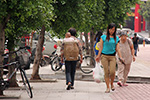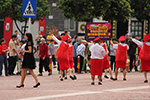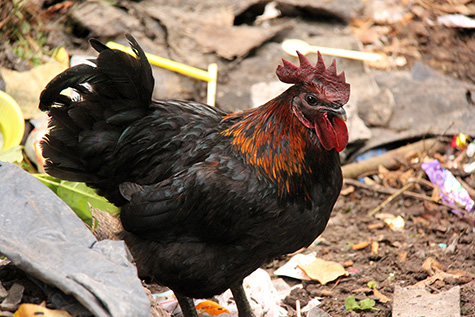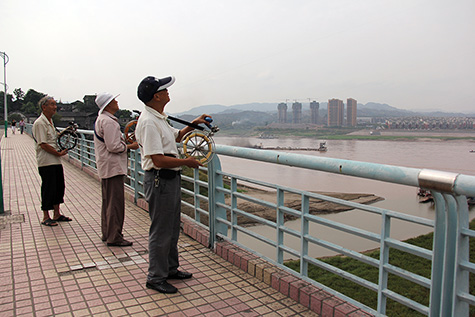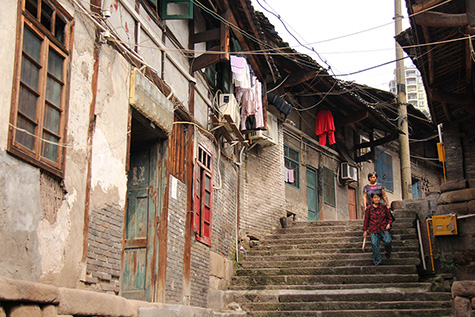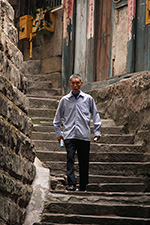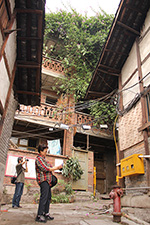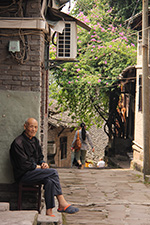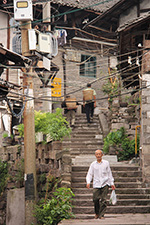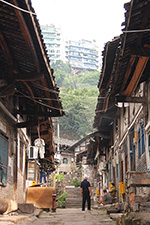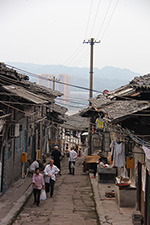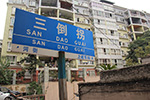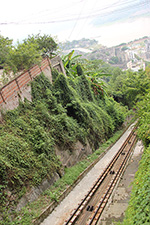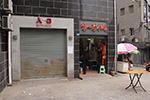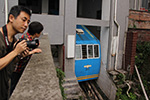of course there was no water this morning. why would there be? enough things have gone wrong with this apartment, what's one more? maybe somebody's doing construction work in the building and temporarily turned it off. naturally they wouldn't tell anyone, that would make too much sense. or if they did - like posting a notice somewhere - it'd be in chinese anyway which i can't read. i realized there was no water after using the toilet. it flushed fine. but when i went to go take my shower, nothing came out. i tried the sink. nothing. i wasn't even mad, just mildly annoyed. but throughout my travels, i've learned to adjust accordingly. that's one of the cardinal rules of traveling in asia, especially in china: not everything will go according to plan. like having running water in the apartment for instance. but i wonder if i don't have water for another reason? since i don't pay my utility bills, could they have shut off my water because of no payment? but i live in a large apartment complex, certainly it can't be that easy just to turn of the water in one unit out of a hundred?
it didn't matter. i would not have water this morning. hopefully later today. in the meantime i could still make breakfast, i still had water left over from boiling an egg yesterday, i could reuse that to boil another one. i got dressed, and sent yuwei a QQ message asking her if her water got shut off as well. i went into the hallway to through away some trash and found some lady neighbors talking loudly. i asked them if they had water. they seemed busy with some sort of housecleaning, but answered in sichuanese which i understood enough to mean they didn't have water either. they told me to speak to the superintendent when i asked them when the water would be back on. then i noticed what they were doing: hauling large buckets of water from downstairs, must be a working hose somewhere. the good news was it wasn't only me. bad news nobody knows when the water would be back on.
i was a little surprised lihui the IT guy didn't contact me about going to go see sandaoguai, but not too surprised because he seems a little irresponsible and prone to lateness. he left work friday afternoon complaining of a toothache and i hadn't seen or heard from him since. he didn't come in saturday because he was cashing in another earned overtime day off. so instead i left the apartment around 8:30 and went to the yonghui supermarket to meet up with mrs.gu. she called me when i almost got there, just to make sure i'd left (i don't like it when people do that, it means they don't trust you to be on time; i was early too, by 15 minutes). she said "they" were waiting so i was curious to see who else she invited. a lovely young office assistant perhaps? it turned out to be a middle-aged man. it seems that young ladies don't enjoy spending their one day off visiting old buildings and streets.
we grabbed the 104 bus which would take us to sandaoguai. the bus was crowded at first, but we were riding it to almost the very end and it got empty enough that we could all sit down. i had a window seat where i could stick out my arm and head to take photos (i only did this occasionally, didn't want to get clipped). i thought maybe we'd get off north of the grand plaza and then walk to sandaoguai, but mrs.gu suggested we start sandaoguai from below. on the other side of the bridge spanning tao hua river was another batch of old architecture worth investigating.
nanjiang old village * chatting with people still living in old village * rooster vs. mantis * old men flying kites * street vendors selling farm-use vegetables seedlings
a woman on the bus saw that we weren't locals and asked if we were reporters. that seemed to be the number one guess amongst curious bystanders. it doesn't seem they get a lot of tourist traffic around here. she then proceded to tell me all the interesting attractions as our bus careened down the hill towards our destination. i appreciated her effort, but wasn't able to fully understand her, even though she was speaking normal mandarin.
once we crossed the tao hua bridge, we got off. below was the tao hua river, which seemed nothing more than a stream flanked on either sides by large expanses of semi-dried mudflats. we were at the mouth of this river which empties into the much large yangtze river next to us. our first stop was a collection of old houses on the opposite side of the river from sandaoguai. the entrance to this area was hidden by an outdoor tea and mahjong parlor, with a few dozen old men eyeballing us out of curiousity.
i'd already been taking photos since i left the house, but our unnamed coworker (he gave me his surname earlier but i of course quickly forgot it) finally pulled out his camera. i noticed his camera bag when we first met, so i knew he was packing some heat. i didn't get a good look at first, thought it was a nikon dSLR with a flare hood on the front of a stocky lens. later i saw what he had, a canon as well, 450D body i think, with a 18-135mm lens. the things he photographed were fairly typical, he was going for more documentation than artistic expression.
this old village - which i'll call nanjiang ("south of the river") old village (i don't think it has an official name, unlike sandaoguai) - is slated for demolition according to mrs.gu, so this trip was extra special in that we were seeing this place before it disappeared. the first thing i noticed was how much trash there was. that's be to expected since the concept of littering as a bad thing doesn't exist in china. i purposely defocused my eyes so i wouldn't have to see the trash. fortunately the dirty parts were near the entrance, and once we entered the heart of this little village, there wasn't as much trash. both my coworker and mrs.gu didn't think anyone lived there, and tried to pry off one of the metal address labels from a door frame as a souvenir. "you better not do that," i said, trying hard to disguise the disgust in my voice. "these places are abandoned," they told me, and went further down the road to try to pry off a different address plate because the one they were working on was too stubborn to remove.
the old village isn't that big, but we only wandered through it a little bit. there may be more, but we were here to see sandaoguai, not old nanjiang village. i found my travel companions in a courtyard speaking with some folks sitting on stools. so much for no one living here. mrs.gu told them this place was slated for demolition, as if telling them something they already knew, but none of them had heard about this, and didn't seem concerned. what infrastructure progress changshou is making, apparently the city planners have forgotten about these people here. it's cheaper to built a new apartment in a new area than demolishing this spot and build on top of it. the simple fact that nobody cares my just very well save places like this, although without the proper care, the place will deteriorate on it own eventually, with or without man's help.
there's a difference between the way i travel and the way my companions travel. when asked what they're doing there, they always seem to hesitate, like they're deciding whether to answer truthfully or not. and when talking to the locals, they don't try to hide the fact that they're not from around here. for me, i tend to smile a lot, to let people know i mean them no harm. a quick friendly smile can go a long way, especially if there are language barriers. i also tread slowly, in case i wander into some off-limited area. i'm also quiet (other than the constant snapping of my camera shutter). and when i talk to people, get down on their level - literally, squatting so i'm speaking face to face instead of talking above them. and i ask them things, like how they're living, questions i care about myself. and when i leave i thank them. my companions did none of these things.
after we made a loop in nanjiang village, we can back out by the mahjong parlor. a rooster was trying to eat a praying mantis, but the mantis was holding its own, displaying a threat posture that seemed to be working and the rooster eventually gave up and walked away. that wasn't the only chicken, there were plenty more, along with dogs. dogs and chickens seem to coexist without problems, although the chickens were still leary of the dogs.
we crossed the bridge, which presented a bunch of photo ops. it's actually more like a road that spans a small body of water. i'd seen this bridge before, from way above wangjiang road scenic vista, brightly lit orange at night. the bridge gets a fair amount of traffic, a good portion of which is bus traffic, which seems to come pretty frequently. below was the tao hua river and stretches of mudflats. this same soil sustained the chinese civilization for milleniums. and here it was, seemingly being eroded into the yangtze river. the mudflat also had a surreal quality about it, like it's hard to tell just how big it is, until you see the few folks fishing along its edges, and the occasional foot print or identifiable garbage sticking out of the mud.
a lot of traffic seemed to be directed at a building where from a distance i could see crowds of people. turns out it's a middle school, and many parents were there registering their child, since school officially begins tomorrow.
i noticed the kites earlier, figured they must be flown from somewhere else farther away because the kites seemed so distant. so imagine my surprise when i saw a group of old men flying kites right from the bridge. i abandoned my companions and crossed over to the other side of the bridge to take a better look. chinese kite flyers are amazing. their rigs are impressive, their industrial-sized spooling mechanism (i'm sure it has a name, i don't know what) shows that they mean business. they spoke to me in thick sichuanese, which i didn't understand except i got that one of them wanted me to take a photo of his kite so he could see it. even with my zoom lens at maximum, his kite was still just a small non-descript trapezoid in the photo. i relocated my companions checking out some roadside vegetable vendors. at first it seemed sort of sad, their selection was rather flimsy, bundles of thin sprouts. maybe tender seedlings taste better i thought, that's why they're harvested so early. but mrs.gu asked them and realized they're actually not for eating, at least not right away. they're sold as seedlings to be grown in your own garden, that's why the prices were a little higher than normal.
sandaoguai ancient street * old soviet-build movie theatre with old theatre sign * free monorail at top of the hill closed
the lower entrance to sandaoguai was also hidden by another mahjong/tea parlor surrounded by a field of garbage. once again men eyed us warily, a bit conspicious with our large cameras and purposeless meandering.
sandaoguai means "three street curve." why "three" i don't really know (is there a one daoguai and two daoguai as well?). maybe they meant mountain ("shan") and got confused and ended up with three ("san") instead. the way it's spelled in chinese differs as well. i thought the "dao" meant street, but when we arrived and saw signs, it was spelled "dao" meaning tilted. elsewhere, further up, we saw it spelled the way earlier way. although the entire winding street is called sandaoguai, only the upper part is actually sandaoguai. further down, the name of the street changes to hoping road, even though its still the same street. basically, try not to make too much sense of the naming convention and just enjoy the street as it is.
sandaoguai doesn't get much traffic, which keeps it from becoming a tourist trap. not many people know about it, only locals, and they don't think much of it, just an old street with old houses. if you want to see old architecture, there are much accessible destinations within major city centers. cixikou in chongqing comes to mind, conveniently located with its own metro stop. but the problem with a place like that is it lacks authenticity. it's a commercial district now, filled with cafes and bars and restaurants and souvenir shops. all of that is still interesting, but if you're looking to see an old part of china, that's not the place to go. however, china is a big place, and you can still find authenticity. the catch is not a lot of people know about these places, which keeps them real, but once people hear about it, it can quickly turn into another ancient town converted into a commercialized tourist attraction (think lijiang in western sichuan, think xitang in zhejiang near shanghai).
searching for in english on the internet comes up with very little hits. search in chinese and your success rate is better, but not by much. it really is a place just known by locals. to be honest, nobody comes to changshou unless they have to, and even then, they probably can't wait to leave. there's nothing to see or do here. their biggest business seems to be providing housing for the many employees who work at one of these multinational companies in the industrial park 30 km away. not like changshou isn't trying though, they did build a changshou ancient town, which is just a garish artificially-manufactured commercial area. i've seen it a few times along the highway, and i'll probably visit at some point out of simple curiousity, but i call it the "fake old town" and it's at the very bottom of my to-do list.
i may very well be the first "westerner" to write a first-hand account of my experience seeing sandaoguai. mrs.gu herself almost visited this place once with her husband, but it was dark she didn't want to risk falling. our coworker friend had heard about this place, but never visited himself. mrs.gu told me that pansusu had been here and loved it, walking up and then down the street so he could admire it twice. how he heard about it was through his local car driver.
sandaoguai the street actually serves a purpose, directly connecting the upper portion of southern changshou with the lower portion, a route that would otherwise only be completed by taking a winding circuitous path down the hill. if you travel via sandaoguai it's more direct but that doesn't mean it's faster. it's foot traffic only, and although it doesn't seem like it, it has a measured distance of 2.5 km, or about 1.5 miles. imagine how long it takes you to walk 1.5 miles. then imagine doing that going uphill. southern changshou (nanjiang) doesn't have a lot of things going for it either, so most people would never come here anyway, unless they either live or work here.
that doesn't mean sandaoguai is a desolate relic. people still use it, but all locals. either people who live in southern changshou, or folks who actually reside in one of the houses lining the street. the only kind of tourists are the occasional group of curious local teenagers. people still live here, but the demographic tends to skew older, for understandable reasons (if you're young, you'll probably want to leave changshou the first thing you can get and move to the big city chongqing an hour drive away).
our plan was to walk up sandaoguai - mrs.gu thought that was easier and safer than walking down - and then take a free trolley back down the hill.
the first building we saw looked like it might've been a store at one point, with a glass storefront that's now boarded up. interesting, yes, but we didn't know the history. then i saw a father come down with his young daughter, and he seemed to be reading something. what i thought to be plywood turned out to be a faded poster of some sort. could this be a remnant of a glorious communist past? i asked mrs.gu to come and help me translate. a passerby came and just dropped some historical knowledge on us unexpectedly. he said this used to be a movie theatre, and what we were looking at is actually a hand-painted movie poster. the movie theatre went out of business in the 1990's (i think). another interesting thing about the building is that it was built with help from the soviet union back in the 1950's (once again, i can't be absolutely sure about these dates).
we continued walking. other than at the entrance, there seems to be very little trash in the rest of sandaoguai. people actually live here, and because of that they tend to keep the place better maintained. we're not talking japanese-style cleanliness, but clean for china. there were a plethora of wooden houses, which in china means it must be old since almost no houses nowadays are built out of wood (cement and steel seems to be the more common material; also wood has a tendency to burn down in a fire). everything was everything, from the way the streets were paved, to the houses, to house electricity is wired to each home, often in a dangerous haphazard way that just advertisement fire hazard. i could've very well spent the entire day here, exploring the area section by section.
occasionally we'd chat with people. they always asked if we were reporters, or possibly surveyors scoping out the terrain. mrs.gu always had a habit of telling people that their homes are scheduled for demolition, not the best way to break the ice. none of the people there believed that to be true though, since sandaoguai has escaped demolition on more than one occasion. just like nanjiang old town, people have simply forgotten about sandaoguai. it's easier for developers to start a new apartment at a new location than try to pay everyone off to leave sandaoguai, tear everything down, and then build anew. mrs.gu told these locals that with some work, they could turn the place into a commercial area (groan) just like cixikou in chongqing. a few of the men scoffed at the idea. not everyone wants to get rich. for these old folks, it's probably better to have a nice and quiet neighborhood to live out the rest of their lives instead of turn their home into a hotel or a bar or a souvenir shop.
one of my favorite things to photograph is people walking up or down the stairs. just the stairs alone seem kind of sparse, add some human element to make it more interesting. this would also be a great location for those cheesy wedding photos the chinese are so keen to take for themselves when they get married. now that i know where it is, sandaoguai is extremely easy to get to. the 104 bus takes you right to the bottom, or you can get off anywhere in old changshou and walk down from the top, taking the 104 back to new changshou.
at the top of sandaoguai was a well, with a clothes cleaning station. not sure where the water comes from and how clean it actually is, but visibly it looks pretty clean, and there were 2 people just finished with clothes washing when we got there.
out on the street, i finally discovered where the top entrance to sandaoguai was. it's not visible from the main street, but i actually passed by here that night when i came to find sandaoguai. it's located right behind the chuan chuan hot pot place. also next door was the trolley station. i saw it last time as well, but because i couldn't read the chinese, i thought it was just a fire station. we tried to take it but unfortunately it's closed with no explanable reason. will it ever be open again? who knows. you can't really see much of sandaoguai from the trolley anyway, it tracks off along the side, surrounded by high plant-covered walls.
but i knew this place well from my first night of wandering, so i told them about the wangjiang scenic vista nearby. after we took a few photos, we headed up into the grand plaza. it was close to noontime and our coworker friend had to go home, not for anything urgent, but to take his weekend afternoon nap. i figured maybe mrs.gu and i could get some lunch, but after we wandered through an outdoor produce market, so said she was going home as well. i turned back so i could go buy a few things.
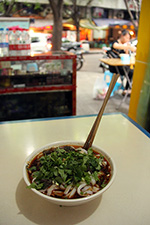 buying a pair of knock-off adidas sneakers (RMB$70) * browsing the outdoor produce market * two parallel hot pot streets * spicy noodles for lunch * riding the 101 back to new changshou
buying a pair of knock-off adidas sneakers (RMB$70) * browsing the outdoor produce market * two parallel hot pot streets * spicy noodles for lunch * riding the 101 back to new changshou
i returned home sometime after 2pm. first thing i did was to test to see if the water was back on. i had a feeling it was working because i saw a trail of leaking water coming from my washer (i forgot to turn off the water supply).
i finished the rest of the layered bread i bought from the produce market. i also peeled one of the large asian pears to see how it tasted. i picked one of the brown ones (usually they're yellow), which when i complained the fruit vendor told me it was just discolored from the sun (and how much he seemed to only give me the brown ones?).  i used my new fruit knife, which will also double as a chopping knife. i usually don't peel things like grapes or apples or pears, it's too much effort. but the skin on these asian pears seem particularly rough and i suspected it was also pretty dirty and it'd give me a chance to risk accidentally cutting myself, something i'm quite good at. the asian pear tasted pretty good. asian pears are pretty common, range from small to large. they're also not as expensive as they are in the US; back home, one pear could cost US$1. here, 5 large pears just RMB$11, less than US$2. actually, i don't remember seeing any other kinds of pears besides these asian ones. fortunately i like asian pears.
i used my new fruit knife, which will also double as a chopping knife. i usually don't peel things like grapes or apples or pears, it's too much effort. but the skin on these asian pears seem particularly rough and i suspected it was also pretty dirty and it'd give me a chance to risk accidentally cutting myself, something i'm quite good at. the asian pear tasted pretty good. asian pears are pretty common, range from small to large. they're also not as expensive as they are in the US; back home, one pear could cost US$1. here, 5 large pears just RMB$11, less than US$2. actually, i don't remember seeing any other kinds of pears besides these asian ones. fortunately i like asian pears.
maybe i should've been working on retroactively updating my blog entires, but i spent the rest of the afternoon catching up on some US television shows instead. i copied them onto a thumb drive and watched them on the HDTV. i caught 2 episodes of the bridge and finished the entire season 2 of the killing. i felt sort of guilty, it seemed wrong somehow. i work so many hours each week that when i don't work it feels strange. also i've spent 2 consecutive sundays running off the chongqing, i don't remember hanging out in my apartment during the daytime other than that first weekend when i arrived.
i was text chatting with fengya today. she seems to be quite the prolific texter, able to respond immediately. she's most likely texting from her phone, while i only do it when i'm in front of a computer. yuwei called me in the early evening. i thought maybe it was another chance to go out for dinner, but she asked if they turned on the water yet (she was in chongqing at the time, about to return home).
when it started getting dark i knew it was time for dinner. i would have noodles again, but one level above ramen. since i only have that just one pot, i had to cook everything in parts. first i boiled the egg. once that was done, i boiled a new pot of water and cooked the baby bokchoi i bought for about a minute. i took out the bokchoi and cooked the noodles. i didn't look too carefully and bought flat thin noodles, which i don't like. once the noodles finished cooking, i poured out the water and added the spicy flavor packet as well as the other ingredients. the bokchoi was a little bitter, the egg kind of just disappeared into the noodles. the noodles had a tendency to clump together, and i would've preferred a noodle soup instead of dry noodles. it wasn't great but edible. fortunately at most i only need to cook once a week. i've got time to think about next sunday night's meal. i might just eat out instead.

